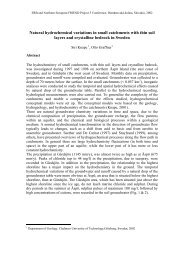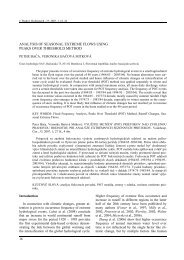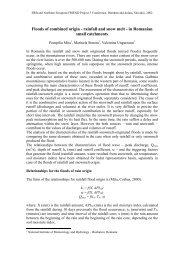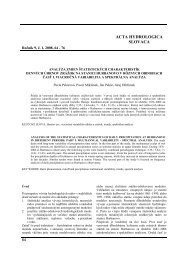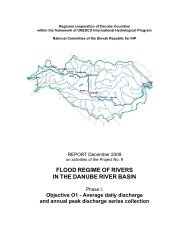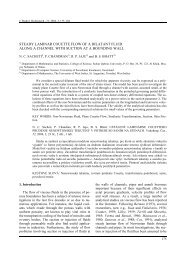LOCAL HEAD LOSS IN PLASTIC PIPELINE JOINT WELDED BY ...
LOCAL HEAD LOSS IN PLASTIC PIPELINE JOINT WELDED BY ...
LOCAL HEAD LOSS IN PLASTIC PIPELINE JOINT WELDED BY ...
Create successful ePaper yourself
Turn your PDF publications into a flip-book with our unique Google optimized e-Paper software.
J. Melichar, J. Háková, J. Veselský, L. Michlík<br />
In case of long pipelines like important water<br />
supply pipeline or penstock into hydroelectric<br />
power plants the way of connecting single plastic<br />
tubes is from the mechanical and economical point<br />
of view important. Besides classical and standard<br />
connecting components for tube connections (e.g.<br />
flanged connection, screwed fitting) in particular<br />
glue connecting (eventually chemical welding<br />
while cold) and thermal welding methods are used.<br />
In general, butt-welding is the most common,<br />
most simple and most reliable way of connecting<br />
pipes for long pipeline conduits from PE and PP<br />
materials. During this process of connecting, which<br />
consists of warming-up and melting the ends of<br />
elements prepared for the connection and following<br />
their pressing down, the inner roughness – the emanation<br />
of the material inside pipeline (see Fig. 1) is<br />
created.<br />
Fig. 1. The thermoplastic pipeline joint welded by the buttwelding<br />
method; PE left, PP right.<br />
Obr. 1. Spoj trubek z termoplastů svařovaných metodou na<br />
tupo; PE vlevo, PP vpravo.<br />
The size of a butt weld joint is for certain material<br />
and wall thickness dependent on the welding<br />
process. The exact welding techniques are recommended<br />
for example by instructions of DVS<br />
(Deutscher Verband für Schweisstechnik). The<br />
inner butt weld in the tube represents the specific<br />
kind of inner resistance and results in additional<br />
losses of the fluid flow. The effect of local losses<br />
caused by butt welds on total energy balance for<br />
long pipelines is important. However, in design<br />
practice it is often underestimated or neglected. The<br />
adverse influence of the butt welds on head losses<br />
for fluid flow in a pipeline and a possibility of creation<br />
of cavitation in the jointing point under high<br />
flow velocity is possible to eliminate by using the<br />
300<br />
apparatus for elimination of inner projections, alternatively<br />
by more expensive connecting technology.<br />
However, in design practise it is paradoxically<br />
preferred the use of least expensive connecting<br />
technology over a possibility to eliminate the local<br />
losses and reduce the operating costs.<br />
Insufficient amount of information for the determination<br />
of a local loss coefficient ζ for the butt<br />
weld with a projection is the main problem in design<br />
practice. A certain simplification, for example<br />
approximate analogy between butt weld projections<br />
and an orifice, was considered. However, these<br />
values of the local loss coefficient were only rough<br />
estimates, anticipated parameters of designed systems<br />
were often largely different from real parameters<br />
that were determined after the construction.<br />
Experimental works in the Czech Technical University<br />
Prague, Faculty of Mechanical Engineering<br />
were carried out in order to obtain quantitative values<br />
that provide more accurate assessment of the<br />
local losses for butt welds in jointing point of plastic<br />
pipe from PP and PE materials. The main aim of<br />
this research was to determine the fundamental data<br />
on the local losses that should be usable in design<br />
practice.<br />
The experimental assessment of the local loss<br />
coefficient of the butt weld in jointing point<br />
in PP pipeline<br />
Fig. 2 shows the pipe test that was constructed in<br />
order to determine the local losses for the butt<br />
welds.<br />
The hydrodynamic pump powered by an asynchronous<br />
electric motor provides flow of water<br />
through pipeline. The flow rate through measuring<br />
part of the pipe is possible to change by alternation<br />
of the pump rotation speed through frequency converter<br />
with full open regulation valve situated in the<br />
end of the test loop or by closing and/or opening of<br />
the valve at constant pump speed. The test section<br />
of the test loop (see Fig. 3) was made of straight<br />
polypropylene tube 90 x 8.2 βPP-H S5/SDR11<br />
(equivalent 90 DN80/PN16), which was commercially<br />
available from the manufacturer Georg<br />
Fischer +GF+. These plastic tubes are supplied at<br />
5 m sections. Allowed manufacturing tolerance of<br />
external diameter and wall thickness is prescribed<br />
by the D<strong>IN</strong> 8077 standard and corresponds also<br />
with ISO 4065 standard. The average value of inner<br />
tube diameter in joints d = 72.5 mm was ascertained<br />
by metering.




